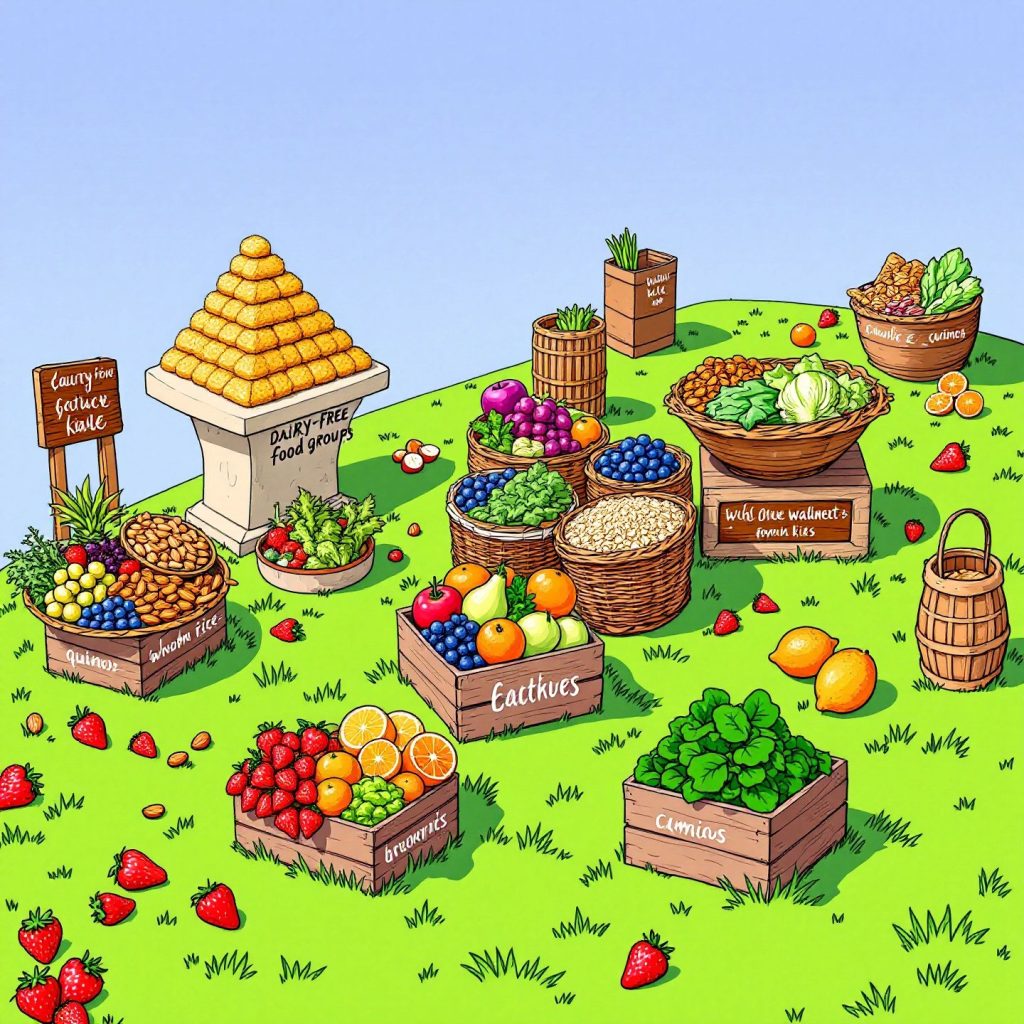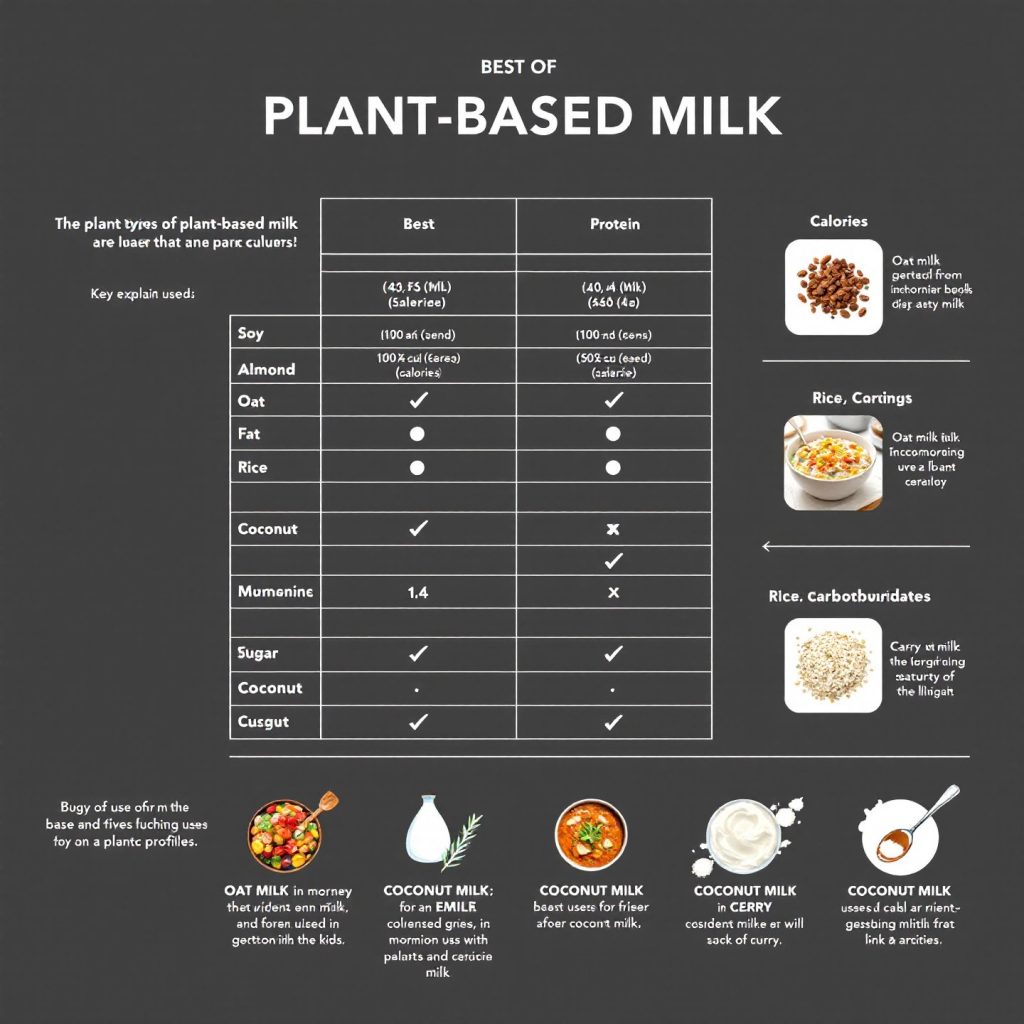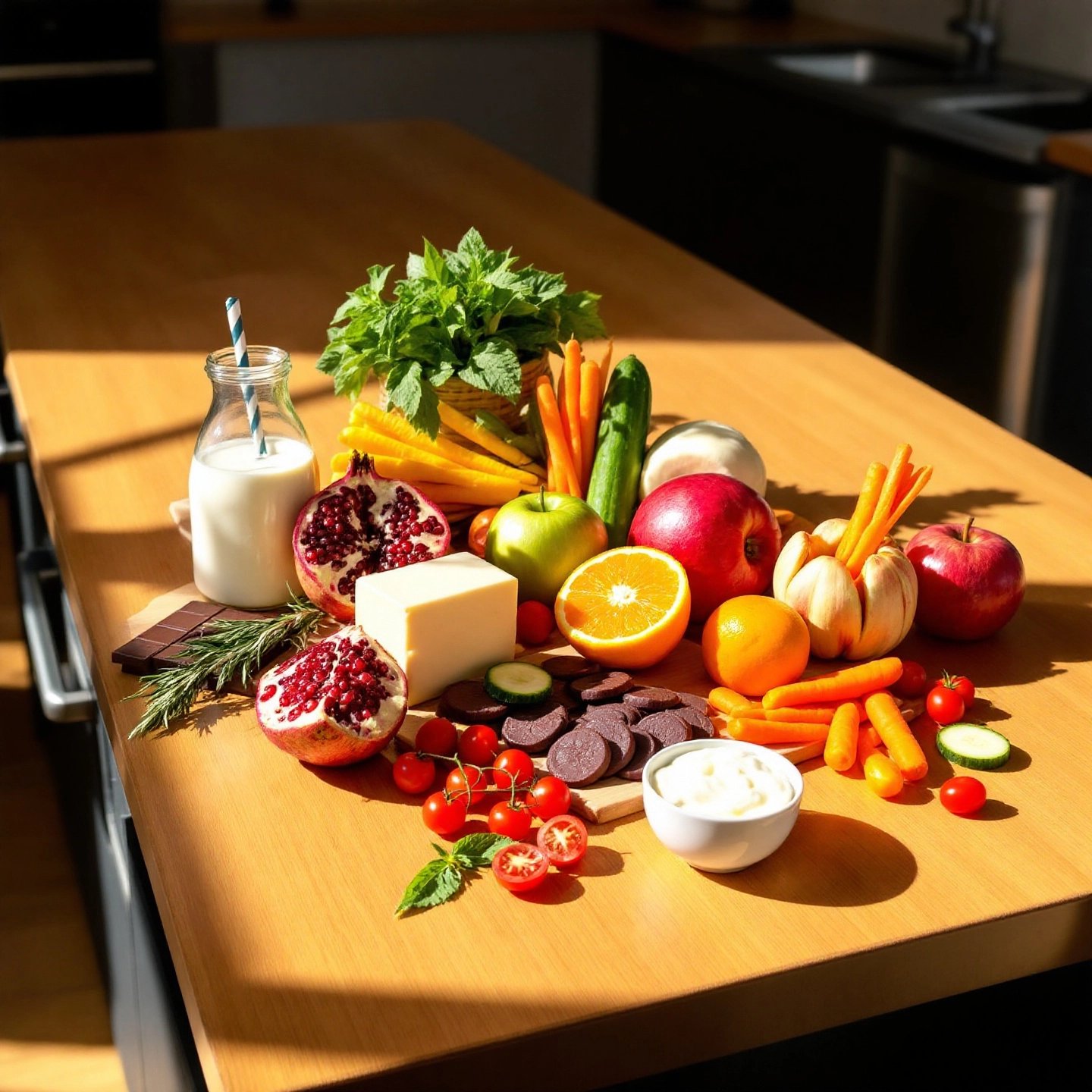Introduction: Understanding the Rise of Dairy-Free Diets
In recent years, dairy-free foods have surged in popularity, becoming a staple for many seeking to improve their health or align with ethical values. The shift towards a dairy-free diet is often driven by a range of factors, including lactose intolerance, milk allergies, and personal health preferences. For some, the decision is rooted in ethical considerations such as animal welfare and environmental impact, as reducing dairy consumption can contribute to a lower carbon footprint (Barry Callebaut).
The benefits of a dairy-free diet extend beyond alleviating discomfort from lactose intolerance or allergies. Many individuals report improvements in digestive health and a reduction in symptoms like bloating and gas after eliminating dairy from their diets (Verywell Health). Additionally, some choose dairy-free options to explore new taste profiles and culinary experiences, which are increasingly available in the market.
The market for dairy-free foods is expanding rapidly, with a diverse array of products now available in grocery stores and restaurants worldwide. This includes not only traditional dairy substitutes like almond and soy milk but also innovative products such as dairy-free cheeses, yogurts, and ice creams. The rise of flexitarian diets, where individuals predominantly eat plant-based foods while occasionally consuming meat or dairy, further fuels this trend (Barry Callebaut).
As the demand for dairy-free options continues to grow, it is evident that these foods are not just a passing trend but a significant shift in dietary preferences. Whether motivated by health, ethics, or the desire for culinary adventure, the reasons for going dairy-free are as varied as the individuals who choose this path. Embracing a dairy-free diet can be a rewarding journey, offering both health benefits and the opportunity to contribute positively to the planet.

Dairy-free food groups: fruits, vegetables, grains, nuts, and legumes (AI-generated)
Essential Dairy-Free Food Groups
Transitioning to a dairy-free diet can seem daunting, but understanding the core food groups that are naturally dairy-free can ease this transition and ensure that your diet remains balanced and nutritious. Many staple foods are inherently free from dairy, offering a wealth of options to satisfy your dietary needs.
Fruits and Vegetables: The Cornerstones
Fruits and vegetables are fundamental components of any healthy diet, including dairy-free ones. Rich in vitamins, minerals, and antioxidants, they provide essential nutrients that support overall health. Leafy greens like spinach and kale are particularly beneficial, offering high levels of calcium and vitamin K, which are crucial for bone health. Berries, citrus fruits, and cruciferous vegetables like broccoli also contribute vital nutrients and fiber, promoting digestive health and reducing inflammation.
Grains and Legumes: Nutrient-Dense Staples
Grains and legumes are excellent sources of complex carbohydrates and proteins, making them vital for a dairy-free diet. Whole grains such as quinoa, brown rice, and oats offer fiber, B vitamins, and iron, supporting energy levels and metabolic health. Legumes, including lentils, chickpeas, and black beans, are rich in protein and fiber, helping to maintain satiety and muscle health. These foods can easily replace dairy-based proteins, ensuring that your diet remains balanced and fulfilling.
Nuts and Seeds: Protein and Healthy Fats
Nuts and seeds are powerhouse foods that provide healthy fats, protein, and a range of essential nutrients. Almonds, walnuts, chia seeds, and flaxseeds are particularly beneficial, offering omega-3 fatty acids, which support heart health. They also contain magnesium and zinc, minerals that are important for immune function and muscle recovery. Incorporating a variety of nuts and seeds into your diet can help fill nutritional gaps left by eliminating dairy.
These dairy-free food groups not only form the foundation of a nutritious diet but also offer diverse culinary possibilities. By focusing on these naturally dairy-free options, you can enjoy a well-rounded diet that supports your health and dietary preferences. As you explore these foods, you’ll find that maintaining a dairy-free lifestyle is both achievable and rewarding, paving the way for a healthier you.

Comparative chart of popular plant-based milk alternatives (AI-generated)
Dairy-Free Milk Alternatives: A Comprehensive Guide
As the demand for dairy-free foods continues to grow, plant-based milk alternatives have become a staple in many households. These alternatives not only cater to those with lactose intolerance or milk allergies but also appeal to individuals seeking healthier or more sustainable options. Among the popular choices are soy, almond, oat, rice, and coconut milk, each offering unique nutritional profiles and culinary uses.
Soy Milk: The Nutritional Powerhouse
Soy milk stands out as one of the most nutritionally comparable substitutes to cow’s milk. It contains about 6 grams of protein per cup, providing all nine essential amino acids, making it a complete protein source. This makes soy milk an excellent choice for those looking to maintain protein intake without dairy. Additionally, many soy milk brands are fortified with calcium and vitamin D, enhancing their nutritional value and supporting bone health (Go Dairy Free).
Almond Milk: Low in Calories, Rich in Calcium
Almond milk is a popular choice for those seeking a low-calorie option. With only about 39 calories per cup, it is significantly lower in calories than both cow’s milk and other plant-based options. Despite its low protein content, almond milk is often fortified with calcium, providing about 482 mg per cup, surpassing even dairy milk in calcium content (GoodRx). Its mild flavor and light texture make it ideal for smoothies and coffee.
Oat Milk: Creamy and Versatile
Oat milk has gained popularity for its creamy texture and subtly sweet taste, making it a favorite for lattes and baking. It contains more carbohydrates and fiber than other plant-based milks, offering about 2 grams of fiber per cup, which can aid in digestive health. Oat milk is also a good source of calcium when fortified, providing around 350 mg per cup (Go Dairy Free).
Coconut Milk: A Unique Flavor Profile
Coconut milk, with its distinct tropical flavor, is often used in cooking, particularly in curries and desserts. While it lacks protein and calcium, its high-fat content provides a rich, creamy texture. For those seeking calcium, opting for fortified versions is recommended. Coconut milk can also be a suitable option for those with nut allergies.
Rice Milk: Allergy-Friendly Option
Rice milk is known for being one of the most hypoallergenic plant-based milks, making it suitable for individuals with multiple food allergies. It is higher in carbohydrates but lower in protein compared to other options. Rice milk is often fortified with calcium and vitamin D, making it a viable alternative for those needing to avoid nuts and soy.
When selecting the best dairy-free milk substitute, consider your dietary needs, taste preferences, and nutritional goals. Fortified options are crucial for ensuring adequate intake of essential nutrients like calcium and vitamin D. For those interested in making their own plant-based milk, exploring top plant milk makers can provide fresh, preservative-free alternatives tailored to individual tastes and nutritional needs. Explore top plant milk makers of 2024 to discover convenient and eco-friendly choices for homemade plant-based milk enthusiasts.
Dairy-Free Cheese, Yogurt, and Other Alternatives
The world of dairy-free foods has expanded significantly, offering a broad range of alternatives to traditional dairy products like cheese, yogurt, butter, and ice cream. These products cater to those with lactose intolerance, milk allergies, or dietary preferences, providing delicious and nutritious options without compromising on taste or texture.
Dairy-Free Cheese Alternatives
Cheese lovers can rejoice with the variety of dairy-free cheese alternatives available today. Brands like Daiya, Kite Hill, and Violife offer a range of options, from slices and shreds to blocks and spreads. These products often use ingredients like nuts, soy, or coconut oil as a base, and are enhanced with nutritional yeast to mimic the savory flavor of traditional cheese. Nutritionally, these alternatives can be rich in healthy fats and sometimes fortified with calcium and vitamin B12, important for those avoiding dairy (Go Dairy Free).
Non-Dairy Yogurt Options
For yogurt enthusiasts, non-dairy options are plentiful and diverse. Almond, coconut, and soy-based yogurts are popular, each offering unique textures and flavors. Almond and soy yogurts often provide a good source of protein, while coconut yogurt is known for its creamy richness. Many brands fortify their products with probiotics, calcium, and vitamin D, making them a nutritious choice for maintaining gut health and bone strength. When selecting non-dairy yogurt, consider your taste preference and dietary needs, as some may contain added sugars.
Butter and Ice Cream Substitutes
Dairy-free butter alternatives, such as those made from coconut oil or avocado, offer the same creamy texture and spreadability as traditional butter. These products are excellent for baking and cooking, providing a rich flavor without the dairy. For ice cream lovers, brands like So Delicious and Ben & Jerry’s offer a range of non-dairy ice creams made from almond, coconut, or cashew milk. These treats are often lower in saturated fat than their dairy counterparts and come in a variety of flavors to satisfy any craving.
Incorporating these dairy-free alternatives into your diet can be seamless with a few tips. When cooking or baking, consider the flavor profiles and textures of these substitutes to achieve the best results. For instance, coconut-based products add a subtle sweetness, while nut-based options may impart a richer, nuttier flavor. By exploring these dairy-free options, you can enjoy your favorite dishes without compromising on taste or nutrition, paving the way for a satisfying and health-conscious diet.

Reading labels to identify hidden dairy ingredients in foods (AI-generated)
Navigating Dairy-Free Eating: Tips for Dining Out and Reading Labels
Maintaining a dairy-free diet can be challenging, especially when dining out or shopping for groceries. Hidden dairy in foods is a common issue, as many processed items and restaurant dishes contain unexpected dairy ingredients. By understanding how to identify these ingredients and effectively communicate your dietary needs, you can enjoy a dairy-free lifestyle with confidence.
Identifying Hidden Dairy in Foods
Many processed foods contain dairy-derived ingredients that are not immediately obvious. For instance, products like breadcrumbs, croutons, and certain snack foods often include milk derivatives such as whey or casein. Even seemingly innocuous items like some gums and sherbet can contain dairy (Simply Whisked). It’s crucial to read ingredient labels carefully and look for terms like “lactose,” “casein,” and “whey” to avoid these hidden sources.
Mastering Food Label Reading
To ensure a product is truly dairy-free, always check the ingredient list and allergen statements. The Food Allergen Labeling and Consumer Protection Act (FALCPA) mandates that the top eight allergens, including milk, must be clearly listed on food labels. However, some products may still have misleading labels, so it’s essential to verify by reading the full ingredient list (Go Dairy Free). If in doubt, reach out to the manufacturer for clarification.
Dairy-Free Dining Out Tips
When eating out, communicate your dietary needs clearly to restaurant staff. Ask questions about menu items and how they are prepared. Many restaurants are accommodating and can modify dishes to suit a dairy-free diet. It’s also helpful to research menus in advance or choose restaurants known for their vegan or allergy-friendly options. Consider using apps or websites that provide reviews and recommendations for dairy-free dining to make informed choices.
By being vigilant about reading labels and openly communicating with food service providers, you can successfully navigate a dairy-free diet. These strategies not only help avoid hidden dairy in foods but also empower you to enjoy meals with peace of mind. As you grow more accustomed to identifying dairy-free options, you’ll find it easier to maintain your dietary preferences in various settings.
Nutritional Considerations for a Dairy-Free Diet
Adopting a dairy-free diet can bring several health benefits, but it’s crucial to ensure that nutritional needs are adequately met, particularly for essential nutrients like calcium, vitamin D, and protein. These nutrients play vital roles in maintaining bone health, muscle function, and overall well-being.
Calcium Sources Without Dairy
Calcium is essential for strong bones and teeth, and while dairy products are a well-known source, there are plenty of dairy-free options to consider. Foods like chia seeds, almonds, and fortified plant-based milks such as soy milk can provide substantial amounts of calcium. For instance, one cup of fortified soy milk contains about the same calcium level as cow’s milk (Medical News Today). Additionally, leafy greens like kale and broccoli, as well as tofu, are excellent sources of calcium, making them valuable additions to a dairy-free diet.
Ensuring Adequate Vitamin D Intake
Vitamin D is crucial for calcium absorption and bone health. Since it is not naturally abundant in many foods, those on a dairy-free diet should focus on fortified foods and sensible sun exposure to meet their vitamin D needs. Fortified plant-based milks and juices, along with certain mushrooms like maitake and portobello, can help boost vitamin D intake (Health Digest). In some cases, vitamin D supplements may be necessary, particularly in regions with limited sunlight.
Protein-Rich Dairy-Free Foods
Protein is another critical nutrient to focus on when eliminating dairy. Fortunately, there are numerous plant-based sources of protein, including legumes, nuts, seeds, and whole grains. Foods like lentils, chickpeas, and quinoa are not only rich in protein but also provide a range of other essential nutrients, making them excellent staples in a dairy-free diet.
While it is possible to meet all nutritional requirements with a well-planned dairy-free diet, some individuals may benefit from supplements, especially if they have higher nutritional needs or dietary restrictions. Consulting with a healthcare professional or registered dietitian can provide personalized guidance to ensure nutritional adequacy and address any potential deficiencies.
By carefully selecting nutrient-rich foods and considering fortified options, those following a dairy-free lifestyle can maintain optimal health and enjoy a balanced diet. Understanding these nutritional considerations is key to thriving on a dairy-free diet, paving the way for a healthier, more sustainable lifestyle.
Delicious Dairy-Free Recipes and Meal Ideas
Embracing a dairy-free lifestyle doesn’t mean sacrificing flavor or variety in your meals. With a plethora of easy dairy-free recipes available, you can enjoy delicious breakfast, lunch, dinner, and snack options that cater to both savory and sweet cravings. Let’s explore some enticing meal ideas that showcase the versatility of dairy-free cooking.
Breakfast: Energizing Starts
Begin your day with a nourishing breakfast like a chia seed pudding made with almond milk and topped with fresh berries and nuts. For a heartier option, try a tofu scramble infused with turmeric and veggies, served with whole grain toast. These dishes are not only filling but also packed with protein and fiber to keep you energized throughout the morning.
Lunch: Wholesome and Satisfying
For lunch, consider a vibrant quinoa salad with black beans, corn, avocado, and a lime vinaigrette. This dish is rich in protein and healthy fats, perfect for a midday boost. Alternatively, a creamy butternut squash soup, made using coconut milk, offers a comforting and nutritious choice, ideal for cooler days.
Dinner: Flavorful Main Courses
Dinner can be a delightful experience with dishes like dairy-free mushroom risotto, where nutritional yeast adds a cheesy flavor without the dairy. Another option is a spicy chickpea and spinach curry, simmered in coconut milk and served over basmati rice. These meals are not only satisfying but also showcase the depth of flavors achievable in dairy-free cooking.
Snacks and Desserts: Sweet and Savory Treats
When it comes to snacks, homemade almond butter spread on apple slices or a handful of roasted chickpeas can be both nutritious and satisfying. For dessert, indulge in a vegan chocolate mousse made with avocado and cocoa powder, offering a rich and creamy texture that’s sure to please any sweet tooth.
Adapting traditional recipes to be dairy-free can be straightforward. Replace cow’s milk with plant-based alternatives, use coconut cream for richness in desserts, and explore the use of ingredients like nutritional yeast for a cheesy flavor in savory dishes. By incorporating these easy dairy-free recipes into your meal planning, you can enjoy diverse and delicious meals that cater to your dietary preferences without compromising on taste or texture.
Conclusion: Embracing a Dairy-Free Lifestyle
As we’ve explored throughout this guide, adopting a dairy-free lifestyle offers a multitude of benefits, from enhancing personal health to contributing positively to the environment. The accessibility of dairy-free foods has never been greater, with a wide array of delicious alternatives available to suit any palate. By choosing dairy-free options, individuals can experience improvements in digestive health, potentially reduce inflammation, and even manage weight more effectively (Integrative Nutrition).
Moreover, the environmental benefits of reducing dairy consumption are significant. Switching to plant-based alternatives helps lower greenhouse gas emissions and reduces the use of natural resources, making it a sustainable choice for eco-conscious consumers (Our World in Data). This shift not only supports personal health but also contributes to a healthier planet.
For those interested in further personalizing their dairy-free journey, making homemade plant-based milk can be an exciting and rewarding endeavor. Using plant milk makers allows for the creation of fresh, preservative-free milk tailored to individual tastes and nutritional needs. This not only enhances the quality of your dietary intake but also offers a cost-effective and environmentally friendly solution. To explore the best options available, consider checking out the top plant milk makers of 2024, which provide convenience and versatility for homemade milk enthusiasts.
In conclusion, embracing a dairy-free lifestyle is an empowering choice that aligns with both health and environmental goals. By experimenting with new foods and recipes, you can enjoy a diverse and flavorful diet that satisfies your nutritional needs and supports a sustainable future. Whether you’re motivated by health concerns, ethical considerations, or the desire to reduce your environmental footprint, the benefits of a dairy-free lifestyle are both profound and far-reaching.
Frequently Asked Questions About Dairy-Free Foods
1. What foods are free from dairy?
Foods naturally free from dairy include fruits, vegetables, nuts, seeds, legumes, grains, tofu, and tempeh. These can form the base of a balanced dairy-free diet.
2. What are some dairy-free options?
Dairy-free options include plant-based milks like soy, almond, and oat, as well as non-dairy cheeses, yogurts, and ice creams made from nuts, soy, or coconut.
3. Does pasta contain dairy?
Most packaged pasta is dairy-free, made from wheat or semolina. However, always check labels for any added dairy ingredients, especially in flavored or prepared pasta dishes.
4. Is a potato dairy-free?
Yes, potatoes are naturally dairy-free and can be enjoyed in many forms without any dairy ingredients.
5. How can I ensure I get enough calcium on a dairy-free diet?
Incorporate calcium-rich foods like fortified plant milks, leafy greens, almonds, and tofu into your diet. Consider supplements if needed, and consult a dietitian for personalized advice.
